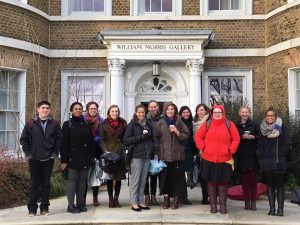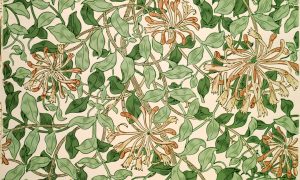May Morris and the Power of Museum Exhibitions
Every January, the first-year fellows of the Winterthur Program and several students in MA and PhD programs from the University of Delaware take part in British Design History: a three-week course on design and material culture with one week at Winterthur and a two-week field study in Great Britain. Traveling to cities including London, Stoke-on-Trent, and Bath, the students have an opportunity to study American Material Culture within a greater global context. Students’ posts in this section are centered on their experiences in England or working with British objects in the Winterthur collection.
In the 2018 British Design History course, we spent three whirlwind weeks examining a number of different objects, artists, and architects, all of whom were integral to British – and to American – material culture. In our studies, we learned about the Arts and Crafts movement. Originating in the late nineteenth century, the Arts and Crafts movement began with British artists and craftspeople dedicated to the importance of beauty and handmade objects in an increasingly industrial world. As we read, looked, and explored, we encountered a familiar name again and again: William Morris. A seminal figure whose ideas contributed to the movement, Morris’s historical identity is intertwined with Arts and Crafts.

The 2018 British Design History Class stands in front of the William Morris Gallery in Walthamstow, London. Photograph by Catharine Dann Roeber.
During our field study in England, we visited the William Morris Gallery and learned about another important figure in the Arts and Crafts movement: May Morris, the youngest daughter of William Morris and Jane Burden Morris. While the shadow cast by her father’s fame formerly obscured May Morris’s contributions to the Arts and Crafts movement, recent scholarship brings her achievements to light. At the William Morris Gallery, we saw this very scholarship in action when we took a tour of the Museum’s exhibition, May Morris: Art and Life with curator Rowan Bain.

Detail of Vine, hanging or portiere, designed by William Morris and embroidered by May Morris and others, c. 1916, colored silks on linen, 98 x 61 in. Photograph by author. This detail shows the simplicity of the stitches May Morris used to execute complicated designs. It also illustrates her skillful attention to color. In 1892, May Morris wrote about the specific shades of purple and yellow that went harmoniously together.
The exhibit, which ran from October 7, 2017 to January 28, 2018, explored May Morris’s experiences with the artistic community into which she was born and the objects she designed and created throughout her life. By hosting the first show to focus on May Morris in nearly thirty years, the William Morris Gallery prompts a re-examination of both William and May Morris’s work. Subtle differences in design, including the use of symmetry, color, and theme, have revealed the artists’ respective hands and led to changes in attribution of some pieces from William to May.

Honeysuckle wallpaper designed by May Morris, c. 1883. Photography copyright William Morris Gallery, London Borough of Waltham Forest. This wallpaper is one example of a work whose attribution has changed from William Morris to May Morris. Though the design may have been published under his name because it was more profitable at the time, curator Rowan Bain explained that Honeysuckle is now thought to be one of May Morris’s first independent designs.
Our visit to May Morris: Art and Life highlighted the power of museum exhibitions to showcase figures otherwise silenced by history. It demonstrated the unique power of objects like the needlework and jewelry of May Morris. When curators and other museum professionals craft a show, they draw attention to these objects, and in doing so, they call for the close-looking and attention that these objects receive when placed in a gallery setting. In turn, that close-looking can reveal information about the people who created the objects. Many makers and artists, like May Morris, may not be present in the historical record for a number of reasons: perhaps their work has been credited to a famous and accomplished father; or perhaps an artist did not sign his or her name; or, like Morris’s many embroideries, a maker did not keep the work he or she created. But, as May Morris: Art and Life showed us, by examining the objects these makers left behind, we may find their voices still echoing through the halls of museums.
Source: Mason, Anna, Jan Marsh, Jenny Lister, Rowan Bain, and Hanne Faurby. May Morris: Arts and Crafts Designer. London: Thames & Hudson in association with the Victoria and Albert Museum, 2017.
By Brooke Baerman, WPAMC Class of 2019

Leave a Reply